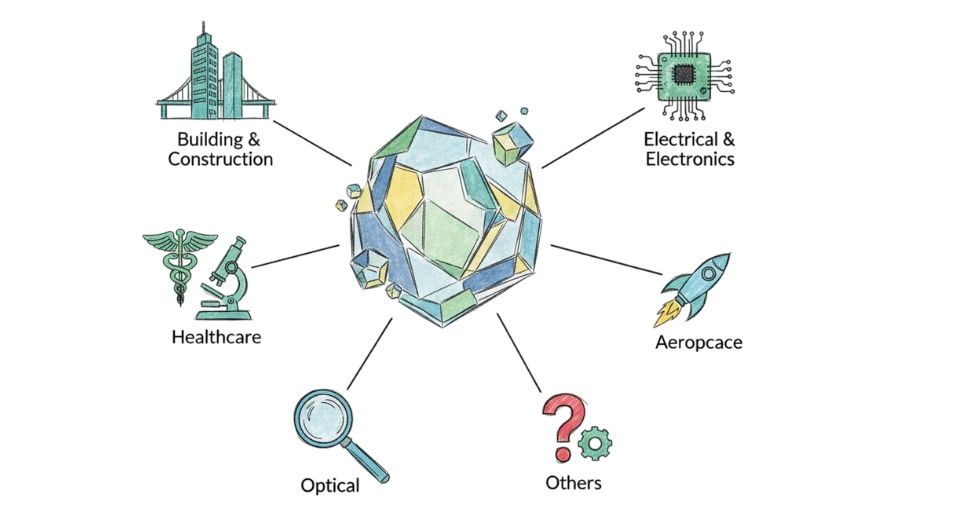
Oct 30, 2025

It is in the most recent Metastat Insight presentation that the global glass ceramics market is envisioned as a realm where design and science converge to redefine durability, precision, and beauty. With their omnipresence in everyday life, it can range from domestic cooking utensils to sophisticated industrial use, working in the background to deliver experience of safety, effectiveness, and innovation. Such an expanding visibility is a sign of a broader trend towards both tough and elastic materials. As businesses look for solutions that are both durable and attractive, glass ceramics are an unsung but revolutionary influence on the creation of things, medicine, energy, and consumer products.
Market Context
Contemporary industries are challenged with the dual task of sacrificing performance for sustainability and affordability. The old materials cannot fulfill new requirements for thermal stability, wear resistivity, and flexibility of design. As manufacturing technologies evolve, more pressure is being put on the creation of materials able to function in severe conditions with minimal environmental impact. In this regard, the glass ceramics market is a pillar that can stimulate development.
Its novel structure and manufacturing processes enable it to provide the link between high-tech ceramics and standard glass, providing manufacturers with a material that is resistant to thermal shock, corrosion resistance, and precision retention across a broad spectrum of challenging environments. The demand from industries like electronics, healthcare, and renewable energy keeps rising, each calling for materials that deliver consistent reliability. Glass ceramics offer this dependability, consistent with the drive for efficiency and optimization of performance. It has opened up the market to being more rather than an around-the-periphery innovation but as a basis to future material engineering.
How It Works / Why It's Valuable
Glass ceramics are manufactured via a process of controlled crystallization that converts glass to a semi-crystal structure with improved mechanical and thermal properties. Products created via this process maintain the clarity and smoothness of glass and the toughness and resistance of ceramics. The result is a product that consistently performs better in applications where temperature, mechanical stress, or chemical exposure variations would otherwise degrade performance.
Their flexibility confers suitability for use in functional and decorative applications. From induction cooking units and dental restoratives to aerospace hardware and optical devices, glass ceramics provide measurable gain in accuracy, safety, and life. They provide manufacturers with the ability to produce thinner, lighter, and more resilient products abilities with direct effects on efficiency of production as well as consumer satisfaction. Along with function, artistic potential provided by glass ceramics have also become the focus, particularly in architecture and consumer product design.
Growth Story / Technological Evolution
Development of the global glass ceramics market has been one of incremental advancement from specialty use to widespread industrial application. The material first was limited to specialty applications but came to be valued for its use under difficult conditions. Thermal processing and crystallization control advances have broadened application and ensured quality reliability. Incremental innovation has increasingly optimized the manufacturing process such that properties like opacity, thermal expansion, and color are typically fine-tuned to serve particular functions.
What had previously been seen as a highly specialized material is increasingly becoming a workhorse used in numerous industries. Advances in research and enhanced manufacturing efficiency have also fostered its introduction into fresh product lines. Steady incorporation of automation, computer modeling, and high-precision engineering has made glass ceramics a general-purpose material equally adaptable to new technology and next-generation products.
Regional and Global Trends
Adoption patterns chart different trends in the major industrial regions. More advanced markets continue to exert dominance in product innovation and development, driven by established production hubs and close relationships between industry players and research institutions. Such markets are focused on high-performance uses, with electronics, defense, and aerospace being favored.
The emerging economies, however, present high growth opportunities with rising investment in renewable technology, infrastructures, and medical technology. The increased industrial capability and sound government policies help drive local manufacturing, with regional integration into the global value chain. With enhanced demand for advanced materials, an additional number of manufacturers begin to appreciate the benefits of glass ceramics for uses as varied as solar technology through to energy storage systems.
Challenges and Opportunities
There are several ongoing challenges to the marketplace. Production cost remains a problem, as high-precision manufacturing and specialized machinery must be utilized in order to fabricate consistently. Competition from other materials, like engineered polymers and composites, continues to drive marketplace strategy. Material safety, recyclability, and energy use regulations during manufacturing also affect operating decisions.
Acrimony set aside, the future is still superb. New fabrication methods, enhanced recycling technologies, and hybrid material science are unlocking glass ceramics' possibilities. Inter-industry convergence, especially electronics and renewable energy, is creating new synergies that will reshape performance standards. Greater focus on circular economy models drives momentum into material development, rendering the glass ceramics sector a prime catalyst for less wasteful production.
Why It Matters Now
Across all sectors, the drive towards efficiency, sustainability, and high performance requires the applicability of the glass ceramics market introduced by Metastat Insight. As the world agendas move towards decarbonization, digitalization, and intensification of resources, materials that can perform in terms of reliability and durability are a key part of the package. Glass ceramics represent a route to light, strong, and environmentally friendly products, consistent with the wider trend to technological stewardship.
From tiny medical equipment to mega energy systems, glass ceramics provide the coordination of design freedom and functional lifetime. Its ongoing evolution in its production process is an expression of the world's broader quest for intelligent materials, those that respond, function, and last. The world market for glass ceramics not only represents scientific advancement but indeed contributes to forming industries for tomorrow.
Drop us an email at:
Call us on:
+1 214 613 5758
+91 73850 57479